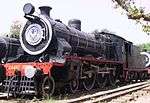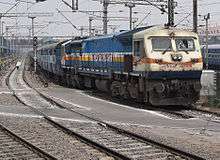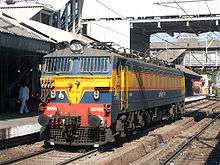Indian locomotive class XS
Indian XS
| Type and origin |
|---|
| Power type |
Steam |
|---|
| Builder |
Vulcan Foundry |
|---|
| Serial number |
4293–4296 |
|---|
| Build date |
1930 |
|---|
| Total produced |
|
|---|
|
|
|
|
|
| Career |
|---|
| Operators |
|
|---|
| Number in class |
|
|---|
| Numbers |
- XS1: 760, 761
- XS2: 780, 781
|
|---|
|
|
[3] |
The Indian locomotive class XS was a class of experimental four-cylinder 4-6-2 "Pacific" type steam locomotives used on broad gauge lines in British India, and then in post-partition Pakistan.[3]
The four members of the class were built by Vulcan Foundry in Newton-le-Willows, Lancashire, England, in 1930. They were divided into two sub-classes, XS1 and XS2, each made up of two locomotives.[3] Upon the partition of India in 1947, they all went to Pakistan.
See also
References
Notes
Bibliography
- Hughes, Hugh (1990). Indian Locomotives: Part 1 – Broad Gauge 1851–1940. Harrow, Middlesex: The Continental Railway Circle. ISBN 0-9503469-8-5.
- Hughes, Hugh (1996). Indian Locomotives: Part 4 – 1941–1990. Harrow, Middlesex: The Continental Railway Circle. ISBN 0-9521655-1-1.
|
|---|
|
| Steam | BESA designs | |
|---|
| IRS designs | |
|---|
| World War II designs | |
|---|
| IGR standard designs | |
|---|
| |
|---|
|
| Diesel | | |
|---|
| Passenger | |
|---|
| Goods |
- WDG 2/3A
- WDG 3B, WDG 3C, WDG 3D
- WDG 4
- WDG 5
|
|---|
| Shunting |
- WDS 1
- WDS 2
- WDS 3/4C
- WDS 4, WDS 4A, WDS 4B, WDS 4D
- WDS 4C
- WDS 5
- WDS 6
- WDS 8
|
|---|
|
|---|
|
| DC electric | Mixed type |
- WCM 1
- WCM 2
- WCM 3
- WCM 4
- WCM 5
- WCM 6
|
|---|
| Passenger |
- WCP 1, WCP 2
- WCP 3, WCP 4
|
|---|
| Goods | |
|---|
|
|---|
|
| AC electric | Mixed type | |
|---|
| Passenger | |
|---|
| |
- WAG 1
- WAG 2
- WAG 3
- WAG 4
- WAG 5
- WAG 5A, WAG 5B
- WAG 6A
- WAG 6B, WAG 6c
- WAG 7
- WAG 9
|
|---|
|
|---|
|
| Dual (AC and DC) electric | |
|---|




